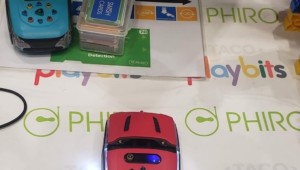Teaching Students to Program in One Hour of Code

Coding is all the rage in educational circles right now. But it’s more than just a fad. In fact, teaching our students how to code is an economic imperative for them and us. According to Time, “the tech sector is set to grow faster than all but five industries by 2020” while offering the best average annual salary, $78,730. That’s a lot of jobs to be filled and a lot of money to be had.
Unfortunately for the U.S. economy and workforce, the vast majority of those jobs will be filled by people outside of the country for one glaring reason, our unwillingness and inability as a national school system to teach real computer science.
The Hour of Code
Enter, The Hour of Code. In recognition of the birthday of computer science pioneer Admiral Grace Murray Hopper, and as part of Computer Science Education Week (December 9-15), The Hour of Code is a call for teachers at all levels and in all subjects of education across the country to introduce students to computer science in a way that demystifies coding as something that everyone can successfully learn how to do.
The Computer Science Education Week website offers a lot of support, resources, and self-guided tutorials along with unplugged tutorials for teaching coding in classrooms without computers. So, whether you’re a devout programmer or someone who has no idea what coding even is, the CSEW website is guaranteed to have a project for you.
Scratch
As for me, I’m going to use Scratch to turn my students into computer programmers in one class period. What is Scratch? It is a drag-and-drop web-based coding software developed by the Lifelong Kindergarten Group at the MIT Media Lab. The group developed Scratch specifically for 8-16 year olds, but as you will see once you become part of the Scratch community, Scratch appeals to people of all ages looking to sharpen their 21st-century skills.
As opposed to other programming software, the user-interface (what you see and interact with on your computer screen) is very user friendly. There is no need to tab between multiple open windows, upload your script to a server, or attach files of code to one another. With Scratch, everything you need is always right in front of you.
Start with a Sprite (a two-dimensional character), drag a few blocks of code from the blocks palette into the script palette, and voila, you’ve coded your very first program. Yes, it really is that easy. However, it doesn’t need to stay that way. Scratch, like many other creative endeavors, naturally scaffolds a user’s experience. To illustrate, when I first logged on to Scratch, I felt like a champ after merely making the default cat sprite move forward and backward to the beat of a drum. But after some more exploration and the help of a few YouTube tutorials, in the span of one hour, I had learned how to create my very own interactive computer game version of Pong.
Let’s Get Scratchin’
If you’re standing frozen at the starting line of learning a computer coding language, you’re not alone. But, to prepare a quality Scratch experience for The Hour of Code, you don’t need to be an expert. You simply need to be willing to learn. To help you get started doing just that, here are a couple of my favorite resources for getting started with Scratch which, best of all, require very little of your time.
User ncgr45e on TeacherTube is a sixth grade teacher at the Ottawa Catholic School in Canada who has assembled a wonderful playlist of short (less than 10 minute) video tutorials, ranging from becoming familiar with the Scratch user interface to putting it all together in a comprehensive project. Whether viewing some of these yourself before you Hour of Code or actually incorporating them into the lesson, this TeacherTube playlist is a valuable resource as you begin Scratchin’.
Similarly, the website Teach Me Programming is an equally valuable tool to use in your Hour of Code. With multiple blog posts, links, videos, and printable worksheets designed to teach students how to use Scratch as well as what people all around the world are doing with the program, Teach Me Programming seems to offer exactly what The Hour of Code is intending, introducing students to the world of computer programming and how easy it actually is to do.
How Will You Teach Them?
Whether you decide to use Scratch, one of the multiple lesson plans available to you on the CSEW website, or plan on going it alone, taking 60 minutes out of the 70,000+ that make up your school year is a small price to pay for in exchange for the possibilities that one-hour will open up for our students. We’re preparing them to enter their world, not the one that we grew up in. How you decide to teach your students to code this December is not important. What is important is actually deciding to teach them.






Jeanne Reed
Thanks for the resources! Have you tried Light-Bot on the computer? I may end up trying Scratch with 4th graders for the Hour of Code classes if I don't get to borrow the iPads for the coding class. Have you tried any of the iPad coding apps (Hopscotch/Light-Bot/Kodable)? Seems so much more fun to me. Not thrilled about Scratch for introducing coding. Maybe it's just a mental block. I appreciated reading your article about it. Thanks again! Cheers! Jeanne
Anne Jenks
Great post! This is going to be so exciting. Our entire school is doing Hour of Code. We have coding games like Kodable, BeeBot, Cato's Hike and Cargo-bot on all of our devices and Scratch has been used in our after school program for two years. Teachers that have been building in coding time daily are finding that students' math reasoning skills are improving.